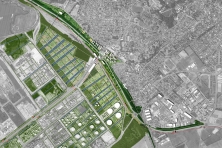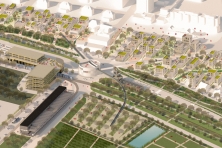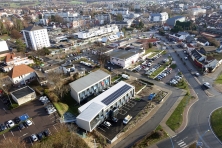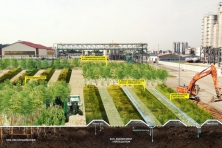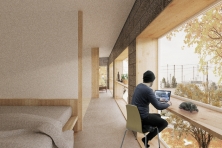La ville école, laboratoire de résilience
Port-Jérôme-sur-Seine (FR) - Runner-up
TEAM DATA
Team Representative: Ugo Nataloni (FR) – architect; Associates: Ulysse Panel (FR) – architect; Malaury Forget (FR) – urban and architecture theorist; Raphaël Prost (FR) – architect urbanist
u² architectures – 64T Quai Gillet, 69004 Lyon (FR)
+33 6 33 91 83 85 - u2architectures@gmail.com
See the complete listing of portraits here
See the site page here

M. Forget, U. Panel, U. Nataloni & R. Prost
VIDEO (by the team)
INTERVIEW
1. How did you form the team for the competition?
We already knew each other from the School of Architecture in Lyon (FR). After graduation we followed different routes. Ugo Nataloni and Ulysse Panel (architects HMONP) have joined forces to create the u² architectures office in Lyon; Malaury Forget (D.E.A) started a thesis at the laboratory “constructive cultures” at the School of Architecture in Grenoble (FR); and Raphaël Prost (D.E.A) continued his studies at Institute of Urban Planning of Lyon (FR) and currently works at URBICAND in Dijon (FR), a consultancy firm specialising in assisting local authorities in the field of land-use planning and local development. Our complementarity and our common vision of the city of tomorrow, frugal and innovative, has strengthened us in the idea of participating to Europan.
2. How do you define the main issue of your project, and how did you answer on this session main topic: the place of productive activities within the city?
Our reflection is to spatially establish the transition from a linear economy to a circular economy, while at the same time making our project part of a resilient approach. We proposed to articulate the two fundamental principles of our project (resilience and circular economy) through a process of various experiments relevant to the entire city and industrial areas. This process is iterative and enables to collect and analyse different kind of data on the field in order to constantly redefine urban issues and solutions. The objective of this process is to achieve the transformation of the oil activity to make room for new productive functions: depollution, agriculture, new energies, and construction technologies, while adapting to the unforeseen that will occur.
3. How did this issue and the questions raised by the site mutation meet?
It is the town history that has brought the two notions of resilience and circular economy into dialogue: a young city that has long been dependent on the oil economy and which aims to reconvert all its energy sources by 2040 through an ecological policy. The team was seduced by the sight of this city of 10,000 inhabitants wanting to emerge from the shadow of the petroleum refinery since the 1930’s. The question of resilience had already been raised, and the next step was to find a method and means of implementing the transformation without imposing an irreversible framework. We have linked this theme to the sub-problematic of the Europan site "How to move from a linear economy to a circular economy? "and propose a method that is both scientific and pedagogical to ensure the transformation of the city.
4. Have you treated this issue previously? What were the reference projects that inspired yours?
The issue of urban resilience has already been addressed in various projects that have been explored personally by the team members, especially during our studies. The circular economy has also been considered for a competition project in 2019 in which the members of u² architectures have participated, and for which we studied the metamorphosis of the business district of Aix-en-provence-Les Milles (FR). In this competition, the transformation of the area is thought through the existing facilities and infrastructures, and envisages re-use as economic, urban and architectural levers. Also, Malaury Forget and Ulysse Panel have worked on the thematic of resilient city in Feyzin (FR) with their respective diploma projects in 2016 and 2015.
In terms of work references, we were inspired by Emscher Park (DE), which concerns the reconversion of an industrial area with a rich landscape work. The guide plan drawn by OMA for the Chemical Valley in Lyon (FR), presents the constraints of the reconversion of industrial areas and depollution as assets to create a productive park in which new industries will settle. Finally, the new town of Milton Keynes (UK), planned in the 1970’s following an ambitious masterplan, includes a large place for experimentation on different scales.
5. Urban-architectural projects like the ones in Europan can only be implemented together with the actors through a negotiated process and in time. How did you consider this issue in your project?
We have integrated the negotiation space with all the players into the very heart of our project. The process that we have defined together consists in putting around a table local actors, but new ones. Indeed, the presence of a new industrial player, H2V, which is developing the hydrogen industry, changes the current relationship to energy production, both for Port-Jérôme-sur-Seine, but also for the entire department. It is therefore possible to see a new category of experts, specialists and researchers arriving to Port-Jérôme-sur-Seine and benefiting from these discoveries made in the field. We believe that applying an experimental protocol on the scale of the whole city will allow to feed the debate and serve local policies while giving a new example of governance including exchange between scientific and territorial management skills.
6. Is it the first time you have been awarded a prize at Europan? How could this help you in your professional career?
Yes, this is the first time that our team has won an award at Europan. We think that it represents a real springboard in terms of visibility but also regarding the rich and pedagogical dimension it will give us. Discovering the diversity and different roles of local actors involved in urbanism, learning to work with them regarding their different roles, or also positioning ourselves in the process of urban development are all new experiences for us that will be necessary for our future professional career. In the case this award gives us the opportunity to have a public order, it will also permit to give life to a new iterative creation process for us. As young architects and urbanists, it represents a huge chance to receive the trust of a city council for several years, and it permits to take the time to propose good and pertinent solutions.
TEAM IDENTITY
Office: Part of the team has a legal form. Ugo Nataloni and Ulysse Panel are the founders and managers of the u² architecture agency in Lyon.
Functions: Architects, urbanists & urban and architecture theorist
Average age of the associates: 28 years old
Has your team, together or separately, already conceived or implemented some projects and/or won any competition? If yes, which ones?
This award for Europan is the first common distinction for the four members of the team. Ugo Nataloni had the special mention for the prize of the Academic Society of Architecture of Lyon (FR) in 2014 and Ulysse Panel was the winner of the Young Architecture Prize of Lyon (FR) in 2015 for his project facing oil refinery of Feyzin (FR). The architects of u² architectures have also led a few individual housing and refurbishment projects.
